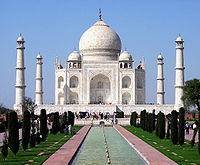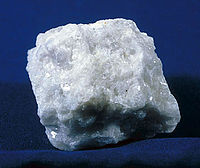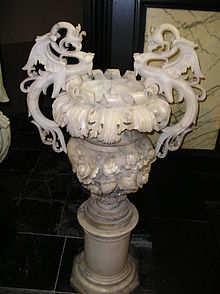- Marble
-
For other uses, see Marble (disambiguation).
 The Taj Mahal is made of marble.
The Taj Mahal is made of marble.
Marble is a metamorphic rock composed of recrystallized carbonate minerals, most commonly calcite or dolomite.
Geologists use the term "marble" to refer to metamorphosed limestone; however stonemasons use the term more broadly to encompass unmetamorphosed limestone.[1]
Marble is commonly used for sculpture and as a building material.
Contents
Etymology
The word "marble" derives from the Greek "μάρμαρον" (mármaron),[2] from "μάρμαρος" (mármaros), "crystalline rock", "shining stone",[3][4] perhaps from the verb "μαρμαίρω" (marmaírō), "to flash, sparkle, gleam".[5] This stem is also the basis for the English word marmoreal, meaning "marble-like."
Whilst the English term resembles the French marbre, most other European languages (e.g. Spanish mármol, Italian marmo, Portuguese mármore, German, Norwegian, Danish and Swedish marmor, Dutch marmer, Polish marmur, Turkish mermer, Czech mramor and Russian мрáмор ) follow the original Greek.
Physical origins
Marble is a rock resulting from metamorphism of sedimentary carbonate rocks, most commonly limestone or dolomite rock. Metamorphism causes variable recrystallization of the original carbonate mineral grains.
The resulting marble rock is typically composed of an interlocking mosaic of carbonate crystals. Primary sedimentary textures and structures of the original carbonate rock (protolith) have typically been modified or destroyed.
Pure white marble is the result of metamorphism of a very pure (silicate-poor) limestone or dolomite protolith. The characteristic swirls and veins of many colored marble varieties are usually due to various mineral impurities such as clay, silt, sand, iron oxides, or chert which were originally present as grains or layers in the limestone.
Green coloration is often due to serpentine resulting from originally high magnesium limestone or dolostone with silica impurities. These various impurities have been mobilized and recrystallized by the intense pressure and heat of the metamorphism.
Types
Main article: List of types of marbleExamples of historically notable marble varieties and locations:
Marble name Color Location Country Bucova Marble white, gray Băuţar, Caraş-Severin County (applied in Ulpia Traiana Sarmizegetusa) Romania Carrara marble white or blue-gray Carrara Italy Connemara marble green Connemara Ireland Creole marble white and blue/black Pickens County, Georgia United States Ziarat White marble Pure white Ziarat Region Pakistan Badal marble Grey, Grayish white NWFP, Baluchistan Pakistan Boticena marble Various Colors and Textures NWFP, Baluchistan Pakistan Etowah marble pink, salmon, rose Pickens County, Georgia United States Macael marble white Macael, Almeria Spain Makrana Marble white Makrana India Murphy Marble white Pickens and Gilmer Counties, Georgia United States Parian marble pure-white, fine-grained Island of Paros Greece Pentelic marble[6] pure-white, fine-grained semitranslucent Penteliko Mountain, Athens Greece Phrygian Marble purple Phrygia Turkey Purbeck Marble Grey/Brown Isle of Purbeck United Kingdom Ruskeala Marble white near Ruskeala, Karelia Russia Sienese Marble yellow, yellowish-white near Sovicille, Tuscany Italy Bianco Sivec white near Prilep Republic of Macedonia Sylacauga marble white Talladega County, Alabama United States Tennessee marble pale pink to cedar-red Knox, Blount and Hawkins Counties, Tennessee United States Vermont Marble white Proctor, Vermont United States Yule Marble uniform pure white near Marble, Colorado United States Wunsiedel Marble white Wunsiedel, Bavaria Germany Uses
Sculpture
White marble has been prized for its use in sculptures since classical times. This preference has to do with its softness, relative isotropy and homogeneity, and a relative resistance to shattering. Also, the low index of refraction of calcite allows light to penetrate several millimeters into the stone before being scattered out, resulting in the characteristic waxy look which gives "life" to marble sculptures of the human body.
Construction marble
Construction marble is a stone which is composed of calcite, dolomite or serpentine which is capable of taking a polish.[7] More generally in construction, specifically the dimension stone trade, the term "marble" is used for any crystalline calcitic rock (and some non-calcitic rocks) useful as building stone. For example, Tennessee marble is really a dense granular fossiliferous gray to pink to maroon Ordovician limestone that geologists call the Holston Formation.
Production
According to the United States Geological Survey, U.S. dimension marble production in 2006 was 46,400 tons valued at $18.1 million, compared to 72,300 tons valued at $18.9 million in 2005. Crushed marble production (for aggregate and industrial uses) in 2006 was 11.8 million tons valued at $116 million, of which 6.5 million tons was finely ground calcium carbonate and the rest was construction aggregate. For comparison, 2005 crushed marble production was 7.76 million tons valued at $58.7 million, of which 4.8 million tons was finely ground calcium carbonate and the rest was construction aggregate. U.S. dimension marble demand is about 1.3 million tons. The DSAN World Demand for (finished) Marble Index has shown a growth of 12% annually for the 2000–2006 period, compared to 10.5% annually for the 2000–2005 period. The largest dimension marble application is tile.
Pakistan is one of the largest marble exporters of the world [8] with exports totaling to around a 100,000 tonnes per annum. China is the chief importer of marble, specifically Pakistani marble, with imports amounting to more than 70,000 tonnes in a single calendar year.
Artificial marble
Marble dust is combined with cement or synthetic resins to make reconstituted or cultured marble. The appearance of marble can be simulated with faux marbling, a painting technique that imitates the stone's color patterns.
Cultural associations
As the favorite medium for Greek and Roman sculptors and architects (see classical sculpture), marble has become a cultural symbol of tradition and refined taste. Its extremely varied and colorful patterns make it a favorite decorative material, and it is often imitated in background patterns for computer displays, etc.
Places named after the stone include Marblehead, Ohio; Marblehead, Massachusetts; Marble Arch, London; the Sea of Marmara; India's Marble Rocks; and the towns of Marble, Minnesota; Marble, Colorado; Marble Falls, Texas, and Marble Hill, Manhattan, New York. The Elgin Marbles are marble sculptures from the Parthenon that are on display in the British Museum. They were brought to Britain by the Earl of Elgin.
See also
- Cultured marble, marble powder with a binder.
- International Association of Marble, Slate and Stone Polishers, Rubbers and Sawyers, Tile and Marble setters' Helpers and Marble Mosaic and Terrazzo Workers' Helpers
- faux marbling, painting surfaces to look like marble.
- Marble sculpture
- Paper marbling
- Pietra dura, inlaying with marble and other stones.
- Scagliola, imitating marble with plasterwork.
- Verd antique – sometimes (erroneously) called "serpentine marble"
- Yule Marble
References
- ^ Kearey, Philip (2001). Dictionary of Geology, Penguin Group, London and New York, p. 163. ISBN 978-0-14-051494-0
- ^ μάρμαρον, Henry George Liddell, Robert Scott, A Greek-English Lexicon, on Perseus Digital Library
- ^ μάρμαρος, Henry George Liddell, Robert Scott, A Greek-English Lexicon, on Perseus Digital Library
- ^ Marble, Compact Oxford English Dictionary. Askoxford.com. Retrieved on 2011-09-30.
- ^ μαρμαίρω, Henry George Liddell, Robert Scott, A Greek-English Lexicon, on Perseus Digital Library
- ^ Pentelic marble – Britannica Online Encyclopedia. Britannica.com. Retrieved on 2011-09-30.
- ^ Marble Institute of America pp. 223 Glossary
- ^ http://tribune.com.pk/story/251020/export-earnings-china-largest-importer-of-marble/
External links
- Dimension Stone Statistics and Information – United States Geological Survey minerals information for dimension stone
- Learning to carve by Marc Levoy.
- USGS 2005 Minerals Yearbook: Stone, Crushed
- USGS 2005 Minerals Yearbook: Stone, Dimension
- USGS 2006 Minerals Yearbook: Stone, Crushed
- USGS 2006 Minerals Yearbook: Stone, Dimension
- Marble Institute of America
Stonemasonry Types Materials List of stone • Artificial stone • Brick • Cast stone • Decorative stones • Dimension stone • Fieldstone • Flagstone • Gabions • Granite • Marble • Mortar • Sandstone • SlateTools Angle grinder • Bush hammer • Ceramic tile cutter • Chisel • Diamond blade • Lewis (lifting appliance) • Non-explosive demolition agents • Plug and feather • Stonemason's hammer • StraightedgeTechniques Products Organizations
Wikimedia Foundation. 2010.





